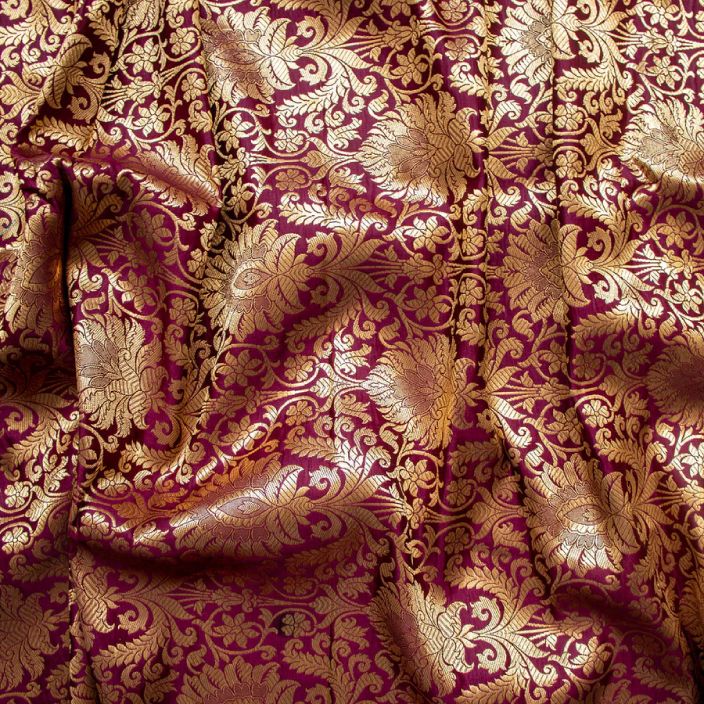For best prices and early deliveries, WhatsApp us at. 918488070070

Brocade
Brocade is a luxurious textile celebrated for its intricate, embossed patterns and opulent appearance, making it a cornerstone of high-end fashion and elegant home décor. Brocade material is traditionally woven with silk, cotton, or a blend of fibres, often incorporating metallic threads like gold or silver to create a shimmering, three-dimensional effect. Its hallmark is the complex designs – floral motifs, paisleys, or geometric shapes, woven directly into the brocade textile using a jacquard loom, which allows for precision and depth in patterning. This distinctive texture, combined with a structured yet breathable drape, renders pure brocade fabric versatile for garments and furnishings, suitable for both warm and cool climates, depending on the fibre composition. The brocade material’s ability to absorb dyes results in a vibrant palette, from rich jewel tones to soft pastels, accommodating bold or subtle designs for diverse aesthetic preferences. Brocade textile is a preferred choice for formal attire, such as sarees, lehengas, sherwanis, and evening gowns, where its lustrous finish and intricate patterns convey sophistication. Pure brocade fabric exudes luxury, ideal for bridal wear, while synthetic blends, often polyester-based, offer durability and affordability, broadening the appeal of brocade material for festive styles. In home décor, brocade textile is used to craft elegant curtains, cushions, and upholstery, adding a refined, timeless charm to living spaces. Environmentally, pure brocade fabric from natural fibres like silk or cotton is biodegradable, though its production is resource-intensive, increasing costs. Synthetic brocade material is more economical but less eco-friendly due to its non-biodegradable nature. By merging traditional weaving techniques with modern technology, brocade textile remains a symbol of craftsmanship and elegance, seamlessly bridging cultural heritage and contemporary trends to create statement pieces for wardrobes and homes worldwide.
The Making of Brocade
The production of brocade fabric is a sophisticated process that weaves intricate, embossed patterns directly into the textile, creating its characteristic luxurious and textured appearance. Utilised for fashion and home décor, brocade textile is crafted from silk, cotton, or synthetic fibres like polyester, with pure brocade fabric often incorporating metallic threads, such as gold or silver, to enhance its opulent sheen. The process combines traditional craftsmanship with modern technology, employing specialised jacquard looms to achieve the brocade material’s distinctive patterns.
The process begins with fibre selection. Pure brocade fabric typically uses silk, extracted from silkworm cocoons, providing a glossy, smooth finish, or cotton, sourced from plants, offering durability and a softer texture. These fibres are spun into fine, high-strength yarns capable of supporting complex patterns. Metallic threads, known as zari, are frequently integrated, requiring precise spinning to maintain consistency and strength for weaving into the brocade textile.
Weaving is the core of brocade production, conducted on a jacquard loom, a historic invention now enhanced with digital controls. Unlike standard looms, the jacquard mechanism manipulates individual threads to create raised patterns, such as florals, paisleys, or geometric designs, giving brocade its three-dimensional texture. Pure silk brocade fabric demands careful handling to preserve its delicate sheen, while synthetic blends allow for more efficient weaving, accommodating various types of brocade textile. The loom’s precision ensures the patterns are seamlessly integrated, contributing to the fabric’s durability and aesthetic appeal.
Post-weaving, brocade textile undergoes finishing processes. Scouring removes impurities, particularly for silk or cotton brocade fabric, which requires gentle treatment to avoid fibre damage. Dyeing introduces a spectrum of colours, from vibrant golds and reds to subtle creams supporting solid hues and intricate patterns. Calendering enhances brocade material’s sheen, especially for polyester blends used in upholstery, while degumming softens silk brocade for a luxurious feel. Rigorous quality checks ensure pattern accuracy and structural integrity, eliminating defects.
Utility
Brocade textile is a highly versatile material employed in women’s dresses, men’s formal attire, children’s clothing, and sophisticated home décor. Its robust, intricately patterned design, typically crafted from silk or cotton, and resilient synthetic brocade material, adapts to various climates, enabling the creation of elegant gowns, tailored suits, and decorative furnishings across different types of brocade textile.
In women’s fashion, brocade material is used in sarees, lehengas, and evening gowns. Pure brocade fabric, with woven patterns like florals or paisleys, often enhanced with metallic threads, is ideal for bridal wear and occasion wear. Synthetic brocade textile offers durability for skirts, blouses, or co-ord sets, blending traditional elegance with contemporary styles. The brocade material’s structured texture supports voluminous silhouettes, such as ball gowns, or fitted designs like jackets, suitable for weddings and cultural celebrations.
In menswear, brocade textile can be seen in sherwanis, bandhgalas, and kurtas. Synthetic brocade material provides durability for tailored blazers or Indo-Western jackets, perfect for formal gatherings, while pure brocade fabric imparts a luxurious texture to evening shirts or waistcoats. Woven patterns add modern sophistication, with breathability ensuring comfort at professional or festive events.
In home décor, brocade textile is used to design curtains, cushions, and upholstery. Its shimmering patterns, often with metallic threads, create a warm, elegant ambience in living rooms or bedrooms. Brocade material is also used in tablecloths, wall hangings, or lampshades, adding sophistication. Its durability ensures furnishings maintain their ornate appearance.
Image Credits
Mohsin Textiles